Mother Earth. 1 CLOTH BOXES.
Twelve Years Worth Of Mother Earth,
With One Of The Last Issues Signed
[Goldman, Emma]. Mother Earth. New York: Emma Goldman, Publisher, 1906-1917.
8vo.; 113 issues in all; wrappers, stapled, covers illustrated; most issues in fine condition. In three specially made cloth slipcases.
113 issues, comprising a nearly complete run of Emma Goldman’s historic anarchist-feminist magazine: the run lacks the especially rare debut issue (Vol. 1, No. 1, March 1906) but it includes an issue signed by Goldman (Vol. XI, No. 6, August 1916)—the only one we have ever encountered—as well as the last full issue of Mother Earth ever published on August 1917 (Vol. XII, No. 6).
Mother Earth reflected Goldman’s eclectic political interests: in it she printed Thoreau, Whitman, Edwin Markham, William Morris, and Mary Wollstonecraft; excerpts from the major liberation writers (Proudhon, Kropotkin, Malatesta, etc.); book reviews by and about Charlotte Perkins Gilman, Theodore Dreiser, and Olive Schreiner. Goldman herself was a prolific contributor, writing about woman’s suffrage, the right to free speech, the fight against sexual slavery, and the fight for birth control. Her biographer Alice Wexler contextualizes Mother Earth within the span of Goldman’s career:
The founding of Mother Earth in March of 1906 was another major turning point for Goldman in her struggle to free herself from her depression of the previous five years, for it marked the realization of a long-cherished dream and gave a definite focus to her work. It crystallized her public persona as mother of the movement–‘Emma Goldman IS Mother Earth,’ acknowledged one friend—and provided the center for a Mother Earth ‘family,’ an informal collective of people who assumed major responsibility for the magazine...Emma’s apartment at 210 East Thirteenth Street now became a kind of clearinghouse and central office for the anarchist movement. In a practical sense, too, the magazine resolved her long-standing dilemma of how to combine wage-earning with political work. In order to support the magazine and, by extension, herself, she would now devote herself full-time to lecturing for pay... (Emma Goldman: An Intimate Life, NY: Pantheon Books, 1984, pp. 120-21)
During the 12 years of its existence—publication was suspended after the U.S. government forbade the distribution of the August 1917 issue—Mother Earth forever changed the face of feminist-anarchist publishing.
The birth of the magazine also signaled the recovery of the anarchist movement from the devastating repercussions of the McKinley assassination. In working through her personal trauma, Emma Goldman had gradually elaborated a vision of anarchism that laid the foundations for a rebuilding of the movement on a new, and controversial, basis...From its militant working class origins in the eighties, the movement would now include middle-class professional people as well: teachers and doctors, pharmacists and journalists, even shopkeepers, salesmen and lawyers. From an emphasis on economic and labor issues, it would accord more importance to social and cultural questions. From an almost exclusively immigrant membership, it would attract native-born sympathizers and supporters... While foreign-language anarchist groups continued to publish and agitate in Yiddish, Italian, German, or Bohemian, Mother Earth—continuing the tradition of The Firebrand and Free Society—sought to create a self-consciously ‘American’ movement, to bring anarchism out of its immigrant enclaves and into the mainstream of American life... (ibid, pp. 121-2)
Goldman took the magazine’s demise as a deep personal loss. “No one will realize the blow this will strike in my heart,” she was overheard to lament. “For twelve years I have struggled and suffered more than any mother has ever done for her child to maintain Mother Earth” (ibid., p. 240).
Nearly complete runs of Mother Earth, especially in fine condition, are painfully scarce, as a
Print Inquire

